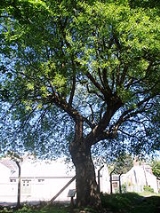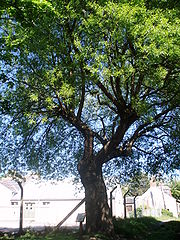
Thomas Lowson
Encyclopedia
Thomas Lowson (c1764–1856) is traditionally held to be the founder of the town of Carnoustie
, Angus
.
 In the late 18th century Charles Gardyne, Freeholder of Ravensby, (or possibly David Gardyne, his elder brother) marked out a road between the villages of Barry and West Haven, using a four horse plough, passing along its way the Point Inn, which stood immediately behind where the Municipal Buildings were built in 1896, opposite Carnoustie Library.
In the late 18th century Charles Gardyne, Freeholder of Ravensby, (or possibly David Gardyne, his elder brother) marked out a road between the villages of Barry and West Haven, using a four horse plough, passing along its way the Point Inn, which stood immediately behind where the Municipal Buildings were built in 1896, opposite Carnoustie Library.
It was along this new road that Thomas Lowson, a loom wright who lived in Barry, was returning home one day in 1797 from a trip to Inverpeffer
. After passing the Point Inn, some say stopping there a while, he took a rest and slept for a while, and upon waking feeling especially refreshed, decided to approach the owner of the land, Major William Phillips, and ask to rent a small area of land. Phillips, the former valet of Panmure estate, bought Carnoustie estate from Bailie Milne in 1792 for the price of £5,000 on his return from India, renaming it 'Taymouth'. Phillips was surprised by Lowson's request, as the land was thought to be agronomically poor, but granted Lowson the first feu of 2 acres (8,093.7 m²) of land for seventy shillings. On hearing about it, Phillips' wife took pity on the apparently deluded Lowson and refunded him five shillings.
In 1798, while transplanting cabbage seedlings on his new land, Lowson left the willow dibble stick he had been using stuck in the ground. He later found it had sprouted leaves. The 'Dibble Tree', a magnificent specimen of Crack Willow (Salix fragilis) can still be seen, off Ferrier Street, and was listed as one of the hundred Treefest Heritage Trees of Scotland in 2006.
Lowson proved his detractors wrong and enjoyed so much success on his land in his first year that a number of his friends applied for feus in the following years. Carnoustie, as the town came to be known, grew over the next few decades such that there were more than a thousand inhabitants 50 years later.
Lowson was married to Barbara Stewart. There is an entry on the Barry Parish Records for July 19, 1799 for the birth of his son, William, where the address is listed as 'Taymouth'. He can be seen on both the 1841 census
, where his occupation is listed as 'carpenter
', and the 1851 census
, where he is listed simply as the 'First Ferth in Carnoustie'. Lowson died in 1856 at the age of 92, and was interred at Barry Parish Church cemetery. His original thatched cottage was improved extensively in the 19th century by his son William and can still be seen on the south side of Dundee Street, not far to the west of The Cross, where it still bears the name 'First Feu Cottage'.
Carnoustie
Carnoustie is a town and former police burgh in the council area of Angus, Scotland. It is situated at the mouth of the Barry Burn on the North Sea coast...
, Angus
Angus
Angus is one of the 32 local government council areas of Scotland, a registration county and a lieutenancy area. The council area borders Aberdeenshire, Perth and Kinross and Dundee City...
.
Biography

It was along this new road that Thomas Lowson, a loom wright who lived in Barry, was returning home one day in 1797 from a trip to Inverpeffer
Inverpeffer
Inverpeffer was a hamlet that once existed in Angus, Scotland until around 1941, when it was demolished during the building of East Haven airfield....
. After passing the Point Inn, some say stopping there a while, he took a rest and slept for a while, and upon waking feeling especially refreshed, decided to approach the owner of the land, Major William Phillips, and ask to rent a small area of land. Phillips, the former valet of Panmure estate, bought Carnoustie estate from Bailie Milne in 1792 for the price of £5,000 on his return from India, renaming it 'Taymouth'. Phillips was surprised by Lowson's request, as the land was thought to be agronomically poor, but granted Lowson the first feu of 2 acres (8,093.7 m²) of land for seventy shillings. On hearing about it, Phillips' wife took pity on the apparently deluded Lowson and refunded him five shillings.
In 1798, while transplanting cabbage seedlings on his new land, Lowson left the willow dibble stick he had been using stuck in the ground. He later found it had sprouted leaves. The 'Dibble Tree', a magnificent specimen of Crack Willow (Salix fragilis) can still be seen, off Ferrier Street, and was listed as one of the hundred Treefest Heritage Trees of Scotland in 2006.
Lowson proved his detractors wrong and enjoyed so much success on his land in his first year that a number of his friends applied for feus in the following years. Carnoustie, as the town came to be known, grew over the next few decades such that there were more than a thousand inhabitants 50 years later.
Lowson was married to Barbara Stewart. There is an entry on the Barry Parish Records for July 19, 1799 for the birth of his son, William, where the address is listed as 'Taymouth'. He can be seen on both the 1841 census
United Kingdom Census 1841
The United Kingdom Census of 1841 recorded the occupants of every UK household on the night of 6 June, 1841. It was described as the "first modern census" in that it was the first to record information about every member of the household and because it was administered as a single event, under...
, where his occupation is listed as 'carpenter
Carpenter
A carpenter is a skilled craftsperson who works with timber to construct, install and maintain buildings, furniture, and other objects. The work, known as carpentry, may involve manual labor and work outdoors....
', and the 1851 census
United Kingdom Census 1851
The United Kingdom Census of 1851 recorded the people residing in every household on the night of 30 March 1851, and was the second of the UK censuses to include details of household members...
, where he is listed simply as the 'First Ferth in Carnoustie'. Lowson died in 1856 at the age of 92, and was interred at Barry Parish Church cemetery. His original thatched cottage was improved extensively in the 19th century by his son William and can still be seen on the south side of Dundee Street, not far to the west of The Cross, where it still bears the name 'First Feu Cottage'.

